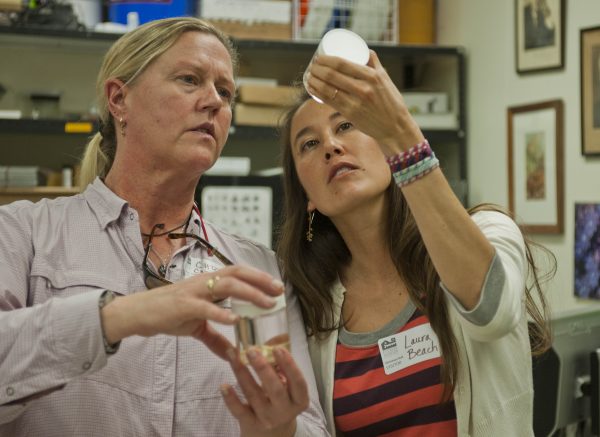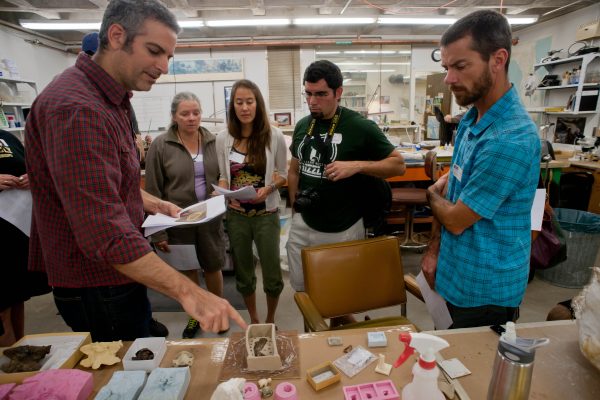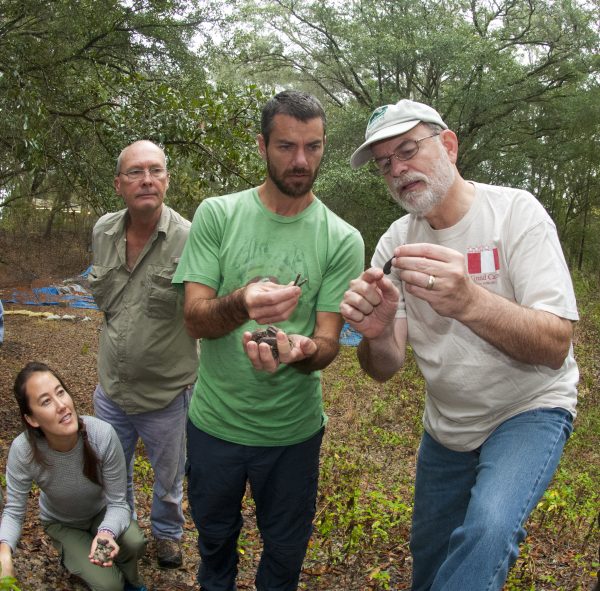
Florida Museum photo by Jeff Gage
From a fossil museum curated by students to a garden used for experimentation, an innovative program that exposes educators to scientific fieldwork is significantly impacting classroom curriculum in California and Florida.
The Florida Museum of Natural History’s Panama Canal Projects’ Partnership for International Research and Education program brings scientists and teachers together to engage in the real world of science through inquiry-based curriculum development during a two-week field trip to Panama. California teachers from Santa Cruz and Watsonville were joined this year by an educator from Florida.
“This experience has allowed me to broaden my students’ horizons,” said Laura Beach, a biology teacher at Soquel High School in Santa Cruz. “Many students think scientists work inside labs all day. Now I can show them that there is a much bigger and exciting scientific world out there that involves experimentation, collaboration and travel.”
While in the field, educators worked alongside the PIRE team of the Panama Canal Project, which aims to advance knowledge of extinct fauna and flora from the ancient Neotropics based on new fossil discoveries along the Canal. Project activities include excavations, documenting findings and interviewing scientists to aid in designing classroom projects.
“It is very rewarding to share in the thrill of scientific discovery with the teachers and to know that they will bring what they learn back into the classrooms to share with their students,” said project leader Bruce MacFadden, Florida Museum vertebrate paleontology curator.
As a conclusion to the program, the 2013 group visited the Florida Museum in December and toured exhibits and collections before participating in an excavation at Thomas Farm in Gilchrist County, an internationally known site that has yielded many species of 18-million-year-old fossils from the early Miocene.
“The trips to Panama and Gainesville really blew me away,” Beach said. “It’s easy for your small classroom to become a microcosm that is disconnected from the greater scientific community. I feel like I have made real-world connections and discovered resources to help bring this wonderfully connected world of science into my small classroom.”

Florida Museum photo by Kristen Grace
To develop a better understanding of why museum collections are crucial to scientific research and conservation efforts, the group toured Dickinson Hall and observed how specimens are prepared for storage. This was the last step in the ‘science cycle’ that participants experienced in 2013, said program assistant Claudia Grant, who organized the trip.
“The teachers saw up-close what happens to specimens once they arrive at the museum where they are cleaned, categorized and studied,” Grant said. “Now they are aware of the whole package—the entire cycle of scientific research from the field to the museum.”
During the tour, researcher Austin Hendy gave an informal seminar on methods to measure and collect data for invertebrate fossils. Educators took this opportunity to collaborate with Hendy and formulate new classroom activities.
Jill Madden, a science teacher at Cesar Chavez Middle School in Santa Cruz, said the opportunity to collaborate with scientists has contributed greatly to her work on school science projects. She is currently partnering with afterschool staff to create an on-site museum featuring fossils from Thomas Farm and Panama, which students will curate.
“The Gainesville trip gave me the opportunity to participate in another type of fossil dig at Thomas Farm and to return to my classroom with more fossils for my students to clean, sort and begin to explore,” Madden said. “Reading about a tiny species of horse that went extinct long ago does not compare to holding the tiny fossilized leg bone or tooth that the horse left behind.”
Museum vertebrate paleontology preparator Jason Bourque taught the group how to make fossil casts and molds and discussed the necessary information and materials needed to replicate the activity in the classroom.
Beach said she plans to add this to her classroom curriculum in the future, along with other ideas resulting from her experience in Gainesville.

Florida Museum photo by Jeff Gage
“I am really excited to eventually add more hands-on components like molds and casts,” she said. “I hope to have students use more manipulatives to learn about science, instead of just pictures. I have already developed an outdoor garden, which students use to perform experiments and document findings in a research journal.”
Scientists will continue post-program collaboration with the educators this year to create 3-D fossil scans and prints, Grant said.
Beach also plans to facilitate communication between students and scientists in her classroom via Skype conversations, so students can ask questions about science, including possible career options.
“I’ve only just begun to incorporate aspects of what I learned in Gainesville and Panama into my curriculum,” she said. “A handful of students have already come to me after class and asked about pathways to a career in science and research.”
Reflecting on the year’s experiences, the educators all described the program as a source of inspiration that will continue to have a strong influence on how they teach science.
“We read about science and we do activities that simulate what scientists do, but this gave us the opportunity to do science,” said Robert Hoffman, a science curriculum coach with the Santa Cruz county school district. “Going back to my job, I feel refreshed and better informed about what scientists do.”
Learn more about the Panama Canal Project Partnership for International Research and Education (PCP PIRE) at the Florida Museum.